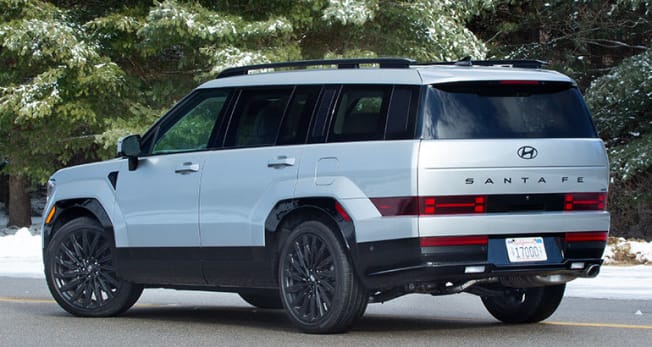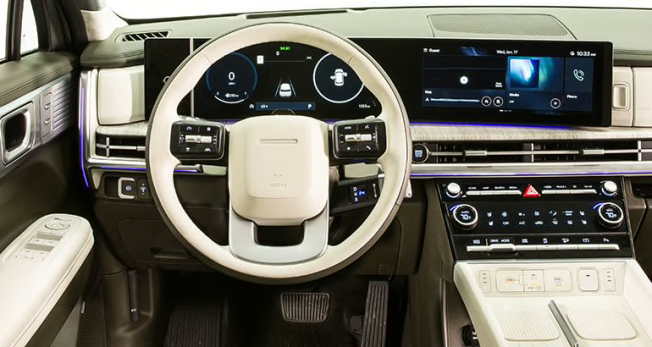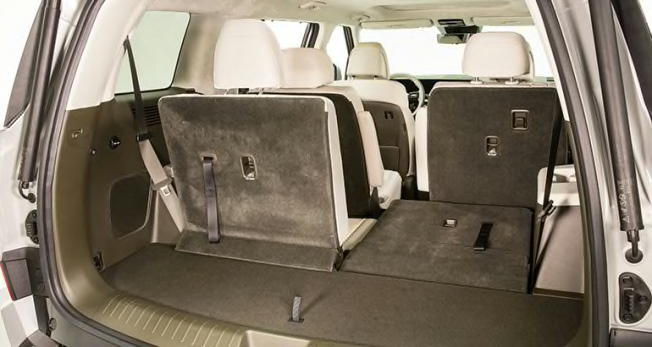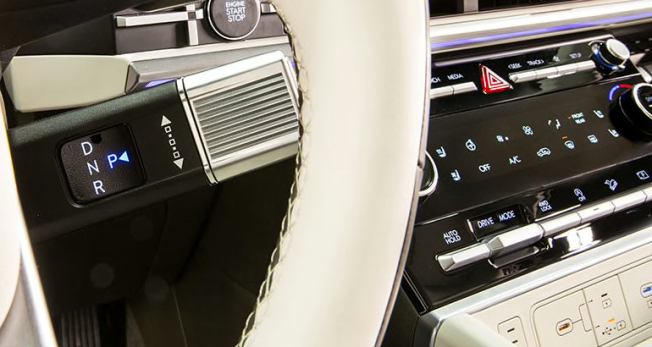First Drive: 2024 Hyundai Santa Fe Dawns as a Polished Tweener
Distinctive styling, clever conveniences, and good road manners promise to make the Sante Fe a compelling alternative to both small and midsized SUVs

The midsized Hyundai Santa Fe SUV is redesigned for the 2024 model year with a distinctive squared-off, rectilinear body. Inside, the cabin design is striking with its big dual-screen display dominating the dash (on top trims, shown below), abundant storage nooks, and a standard third-row seat.
The last Santa Fe was a tweener, being sized between the traditional small and midsized SUVs. This fifth-generation Santa Fe has a longer wheelbase than the 2023 model, providing more legroom to second-row passengers. It is scaled similarly to the related Kia Sorento, putting it right between the likes of the Toyota RAV4 and Highlander.
Two powertrains are offered in the 2024 Hyundai Santa Fe, starting with a 2.5-liter turbocharged four-cylinder engine. A 1.6-liter turbocharged four-cylinder hybrid is only slightly more expensive. Front- and all-wheel drive configurations are available.

Photo: John Powers/Consumer Reports Photo: John Powers/Consumer Reports
CR's Take
Small SUVs continue to grow, with models like the Honda CR-V being larger than the prior generation. To preserve its “tweener” status, the Santa Fe had to grow as well. It is again positioned as the choice for small SUV shoppers who crave a little more room. And with the third-row seat, it now serves as a compelling alternative to three-row midsized SUVs that may be too large or expensive for some shoppers. As with its sibling, the similarly sized three-row Kia Sorento, that rear, fold-away bench seat is best used to transport post-car seat children in a pinch, rather than be regularly employed for larger people, given the tight space and challenging access.
We admittedly sampled the most premium configuration, but dial back the fancy trim, upholstery, and 21-inch wheels, and you’re still left with a compelling SUV with good front- and second-row space, a generous cargo area (with third-row folded), poised powertrain, and respectable road manners.
The Santa Fe seems to draw some design inspiration from the Land Rover Defender, and its low-and-long shape evokes the Ford Flex. But the new Santa Fe carves its own market niche, making it uniquely desirable for its looks, size, performance, and features. It feels like a capable understudy to the Palisade. The Santa Fe proved more refined than its chunky exterior suggests—at least in the Calligraphy trim. We look forward to seeing how an SEL holds up to our initial impressions, and taking measure of the fuel economy in the hybrid.

Photo: John Powers/Consumer Reports Photo: John Powers/Consumer Reports
What We Like
Fit and finish: The Calligraphy cabin is beautifully finished, with suede on pillars, sun visors, and headliner. The luxurious material is soft and smooth to the touch. There is stitched leather on the doors, dash, and center armrest. The striped, birch-like accent trim on the dash is unique and interesting. There are some “H” and horizontal design elements, but the motif is understated. Moving parts, like door release handles and dash vents, have a notably smooth operation. The cabin seems almost too upscale inside for the exterior. Ultimately, the interior finish does answer the question of how this can sticker for almost $50,000.
Access: This is one of the easiest vehicles ever to enter. The floor is lower than some small SUVs and all midsized SUVs. Even shorter drivers found that the low floor and seat base made it an effortless vehicle to step into. The second row isn’t quite as easy, due to the elevated seats. There is some ducking required as you step up, but the flat-shaped roof helps with a wide rectangular door opening.
Driving position: The chairlike seating position is quite comfortable, with tons of headroom and good space for knees, even when sitting splay-legged. The well-positioned left footrest is nice and wide. Both armrests are well-placed, but padding for the door one is hard and the center one is pretty stiff, too. The driver’s right elbow typically falls to the left edge of the center armrest, which is hard plastic. Some drivers found it difficult to position the steering wheel for both comfort and line of sight to the instrument panel, finding themselves having to compromise one for the other.
Front seats: These feel like premium seats borrowed from Genesis. They are certainly a step up from rival models. The leather seems like good quality, with a nice feel and durable impression. Seat base is wide, though torso bolsters are constricting for larger occupants. Some drivers found the seatback to be a bit firm. Power extendable under-thigh support is nice, but most drivers found it frivolous for driving, and there is four-way lumbar adjustment for the driver’s seat.
But you can’t just change the leading-edge tilt for the bottom cushion; adjusting the bottom cushion up or down affects the entire seat. The bottom cushion doesn’t move independently, so you then have to readjust the seatback. There is a button that puts the seat into a lounge position with leg support, like some EVs such as the Kia EV9 now offer, suitable for napping when parked.
Second-row seats: Theater-style seating raises the second row up slightly compared with the front row. The downsides are seen in increased access difficulty and reduced headroom; headroom is still adequate, but it is less than up front. Even with the power tilt base and seatback in the lowest position, the seat bottom is elevated, making it a bit more of a challenge to enter and sit. Once inside, there is plenty of leg and knee room. The space is very open under the front seats, making it easy to tuck your feet there. The seats are flatter and less bolstered than the fronts, as is typically the case to allow them to fold down. Some passengers commented that the captain’s chairs were quite comfortable, especially for the class. Our Calligraphy had some luxuries that enhanced the experience, such as retractable window shades and heated and power tilt/recline. Passengers will appreciate the convenient USB-C charge ports, bag hooks, and large pockets on each front seatback; and dual cup holders on the doors for a drink and added storage.

Photo: John Powers/Consumer Reports Photo: John Powers/Consumer Reports
Cargo space: The square/boxy cargo area maximizes usable space. This is counter to recent styling trends that see sloped rear ends becoming the norm, making the Santa Fe’s practical design refreshing. Space is nominal with the third row in use (think single baseball bat, rather than baseball gear bag). But fold that third row down, and there is a generous cargo area. Plus, there is an underfloor storage nook, alongside the jack, suitable for an emergency kit.
Cabin storage: There are abundant spots for tucking drinks and travel sundries. There is a slim upper glove compartment with an ultraviolet sanitation feature, as well as a traditional glove box. Plus a discrete shelf above the glove box. There is a large open space beneath the dual center charge pads with grippy surfaces, suitable for a pocket book or bag. This open bin has low side walls to keep the contents from spilling into the footwells. The center armrest console is of modest width, but it has multiple tiers and it is deep as a chimney. Plus its cleverly engineered lid hinges both forward and back so it can be accessed by either front or back seaters. There are bottle holders and small storage pockets on the doors.
Visibility: There is good visibility all around, aided by the upright shape. The A-pillars that flank the windshield are relatively slim and don’t get appreciably thicker at the base, so you don’t struggle to see around them through corners. Front and rear side windows are quite large, being both tall and long. The B-pillar, where the rear door hinges, is slim enough to allow for easy over-the-shoulder views when changing lanes. The large third side window is mostly blocked by the second-row headrest, and the rear pillars are very thick. Rear window is wide and tall. Flipping the third-row headrests forward helps the rear view, but be sure to keep them upright if you have third-row passengers.
Powertrain: The 277-hp, 2.5-liter turbocharged four-cylinder engine in our rented Santa Fe provided good acceleration and refinement around town, with ample verve when called upon. It has a cultured feel and sound. Acceleration from a standstill is prompt, without hesitation, but there is a minor delay during rolling stops as the eight-speed dual-clutch automatic finds its place. Once underway, the engine and transmission pair nicely together. There is an occasional “peak and valley” as the transmission may delay a shift, but there is a ton of power when needed for passing. Overall, this is a good combination, akin to what midsized SUVs are fitted with. (It is worth noting that although the Santa Fe is a few inches shorter than some true midsized SUVs, its weight is similar. In fact, its curb weight is a match for the last Highlander we tested.)
Handling: The Santa Fe feels confident and capable, with a natural effort to the steering and some welcomed feedback when cornering. Body roll is restrained in common driving scenarios, though noticeable when charging hard into a corner. Handling is good all around and a virtue for the Santa Fe.
Santa Fe: We like that there is a large “Santa Fe” applied to the rear liftgate. This SUV looks so different from its predecessor that fellow motorists will wonder what it is, based on queries we received while driving it.
What We Don't Like
Gear selector: The odd, unconventional gear selector stalk (shown below) takes some getting used to, as we have experienced in other recent Hyundais. It is on the right of the steering wheel, where the wiper stalk is often located. The driver makes a selection by rotating the tip toward Drive or Reverse. Depending on how you sit, and if the wheel is straight, it can be tricky to see it behind the wheel. But we found you do get used to it with practice.
Passenger climate controls: The second row does not have climate controls, but the third row does. Given that the second row will (or at least should) be used far more often than the rear, and that the rear is likely to be populated by children, who are least likely to be courteous in their HVAC choices, this seems backward. We’d rather the driver have full control over the rear-most climate settings.

Photo: John Powers/Consumer Reports Photo: John Powers/Consumer Reports
Third-row seat (shown above): Most occupants would find legroom to be restrictive, and their knees would be bent tight and pointing up, hinged well above the hips. However, headroom is good. Moving the second row forward helps, and there is space under that row for the rear-most passengers to tuck their feet under the seats. Even with the ability to power the second-row forward, accessing the rather flat third row requires a lithe, athletic figure. The third-row seats may prove helpful for some families that need to carpool in a pinch, but because using the seat consumes nearly all aft cargo space, the ability to take backpacks and sports gear may limit how many students and after-school athletes can be shuttled. Many buyers will wish the third-row could simply be omitted.
21-inch wheels: These are big wheels, wrapped in pricey Pirelli Scorpion tires with short sidewalls. For both resistance to pothole damage and ride quality, we’d favor smaller wheels. For us, any styling benefit isn’t worth the trade-offs.
Exterior vs. interior: In Calligraphy trim, the premium cabin is incongruous with the rather plain exterior. At minimum, the black plastic that surrounds the body like an unpainted baseboard should be body colored. Beyond the oversized wheels, the exterior doesn’t effectively announce that this is an elite configuration.
What We'll Keep an Eye On
Start/stop button: This too can be hidden from sight by the steering wheel.
Climate controls: There is a combination of knobs with a small HVAC touchscreen. This is better organized and separated than the sea of buttons in the last Santa Fe or the quirky dual-mode controls used in Hyundai EVs. But some icons are small, particularly for the fan speed, making them challenging to adjust while driving. We do appreciate that you don’t need to wade into the infotainment touchscreen to activate/adjust seat-heaters/coolers and heated steering wheel, as you do on some other newer models.
Front vents: The center dash vents are positioned under the infotainment screen. Some drivers found that they were a bit low on cold days, when more warmth was desired on their faces.
Ride: The ride quality on our Calligraphy was generally good for a small SUV on giant 21-inch wheels, but some impacts, like highway road seams, punch through. Most road aberrations are absorbed well, but that inconsistency has us eager to experience a lower trim with smaller wheels. We’re optimistic that the experience would be better with the 18-inch wheels that come on the SEL.
Safety and Driver Assistance Systems
The 2024 Hyundai Santa Fe comes with a full suite of active safety and driver assistance systems. Automatic emergency braking (AEB) with pedestrian and cyclist detection, AEB that operates at highway speeds, blind spot warning, rear cross traffic warning, lane keeping assistance, lane centering assistance, adaptive cruise control, rear occupant alert, and driver attention monitoring are all standard.
The driver attention warning system monitors the driver’s inputs and can issue warnings if it determines that the driver isn’t alert. In addition, the forward attention warning uses an infrared camera mounted on the steering column that will track the driver’s eyes and monitor driver attention.
Higher trim levels layer in more features and more advanced versions of the core safety suite. Of note, the rear occupant alert system, starting with SEL, adds ultrasonic sensors and integration with the telematics system. Combined, this more advanced feature can detect motion from an unattended child and notify the driver via their phone.
Also, the XRT, Limited, and Calligraphy trims are available with Highway Driving Assist, a system available with two-levels of collaborative support that adjusts speed and steering on highways. The HDA 2 system on Calligraphy trims can automatically change lanes in certain conditions.




















